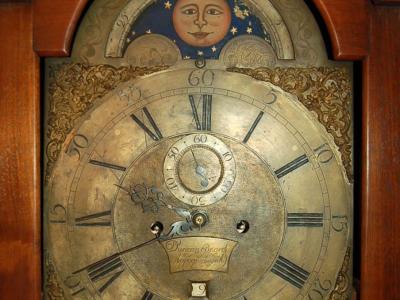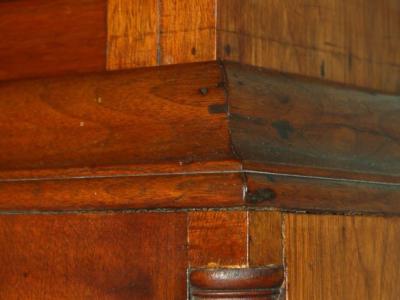Tall clock
Probably Delaware
Late 18th and 20th centuries
Maker
Fake nameplate of Duncan Beard
Measurements
H: 98 in x W: 28 in x Depth: 11 in
Materials
Walnut; tulip poplar and hard pine secondary woods; brass dial and clock movement
Credit Line
Historic Odessa Foundation, gift of Mary E. Kelly & George F. Kelly in memory of Nona and George Kelly
Accession Number
2015.17
Inscription
"Duncan Beard / Appoquinimink" is engraved on a later and inapproriate nameplate on the dial.
Condition Notes
The clock and case have been significantly altered and lack integrity as an antique. See "Comments."
Comments
The clock bears an engraved nameplate identifying Duncan Beard as the clockmaker. The case purports to be of 18th century Delaware fabrication. Both have been "upgraded." A more complete report of October 9, 2015, by Philip Zimmerman is attached.
The dial: All Duncan Beard dials have his name engraved in block letters across the moon arch. The stylized floral vine on this arch is a form of decoration that is unknown on his work.
Beard’s dials typically have beautiful decorative engraving. Compare the dials he made on tall clocks acc. nos. 1975.119 and 1958.3203 to the simple, pebbled treatment on this face.
Beard is not known to have ever used a nameplate. This nameplate screws onto the dial and can be changed easily.
The pediment: The pediment scroll is shallow and low—unlike typical 18th century work. The stamped brass ornament in the center of the pediment scrolls represents a type and style of work the postdates 1810, many years after Duncan Beard died.
Details of the back of bonnet cornice molding and of a corner in the back of the pediment show that wood parts have been stained black—a common way to hide new wood surfaces. The entire pediment of this clock was likely added at a later date to “improve” a simpler, flat-top bonnet.
The waist and base: Color and grain of the wood in the framing members of the waist and the base differ. In contrast, the figured grain and color of the panels appears the same.
A light scribe line scratched into the wood marks the location of the original waist molding.
The engaged quarter columns of the waist and base are made differently. The waist columns are made from separate pieces, as they should; that on the base is made from a single piece of wood, which is not correct workmanship. The base is a complete restoration, except for the base panel, which was likely salvaged from the original base. The feet are also replacements.




